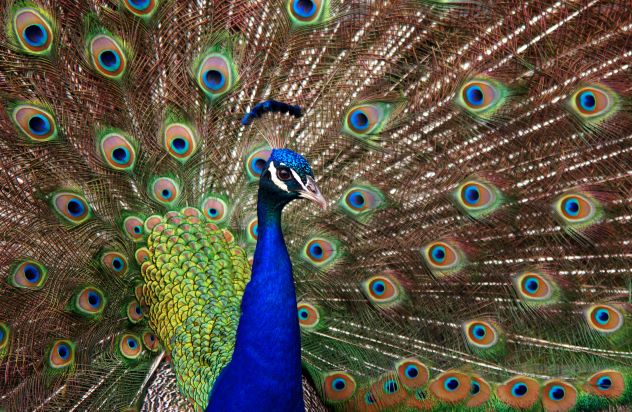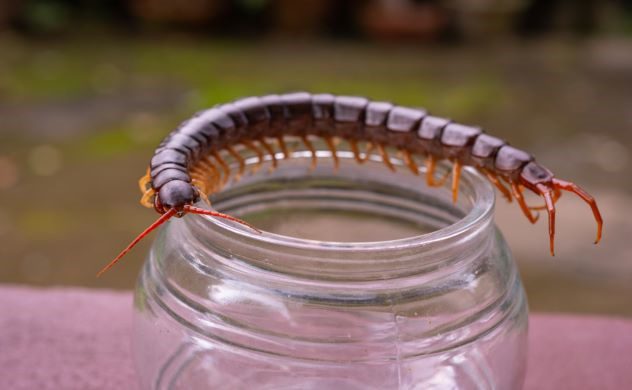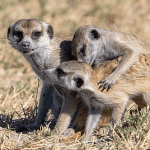 Crime
Crime  Crime
Crime  Politics
Politics 10 Politicians Who Beat a Future President
 Sport
Sport 10 Wild Facts about the Crazy First Years of the Tour de France
 Movies and TV
Movies and TV 10 Great Songs by Fictional Musicians in Movies
 Animals
Animals Ten Astonishing Stories about Underwater Life
 Weird Stuff
Weird Stuff 10 Strange and Unexpected Things Smuggled into Strict Authoritarian Countries
 Our World
Our World 10 Terrible Crimes That Are Destroying the Amazon
 Miscellaneous
Miscellaneous 10 Timely Stories about Clocks
 History
History 10 Magnificent Heroines Who Went Undercover to Defeat the Nazis
 Music
Music 10 Surprising Stories Behind Famous Songs
 Crime
Crime 10 Evil Pastors Who Killed Their Family
 Politics
Politics 10 Politicians Who Beat a Future President
 Sport
Sport 10 Wild Facts about the Crazy First Years of the Tour de France
Who's Behind Listverse?

Jamie Frater
Head Editor
Jamie founded Listverse due to an insatiable desire to share fascinating, obscure, and bizarre facts. He has been a guest speaker on numerous national radio and television stations and is a five time published author.
More About Us Movies and TV
Movies and TV 10 Great Songs by Fictional Musicians in Movies
 Animals
Animals Ten Astonishing Stories about Underwater Life
 Weird Stuff
Weird Stuff 10 Strange and Unexpected Things Smuggled into Strict Authoritarian Countries
 Our World
Our World 10 Terrible Crimes That Are Destroying the Amazon
 Miscellaneous
Miscellaneous 10 Timely Stories about Clocks
 History
History 10 Magnificent Heroines Who Went Undercover to Defeat the Nazis
 Music
Music 10 Surprising Stories Behind Famous Songs
Ten Curses and Omens Connected to Animals
Many today still refuse to allow a black cat to cross their paths, and even if killing a ladybug is considered highly unlucky, most believe it’s not very nice to begin with. Whether they increase a person’s luck or rudely rip it away, there are countless superstitions still floating about in the zeitgeist. Though nowadays, bad luck superstitions such as these are often regarded as fun little games. However, some claim to know of dire curses to be avoided with religious fervor or omens alluding to something dark and horrifying in the near future.
Such curses persist even in contemporary times, and like the legends regarding black cats and rabbit feet, many of these curses are related to animals. Indeed, across the world, tales are told of animals foretelling the death of someone or perhaps the end of a sports team’s winning streak. The breadth of the severity of these curses varies. Either way, curses and omens adjacent to the animal kingdom pop up everywhere, and this list will cover ten of them.
Related: 10 More Creepy Cursed And Haunted Objects
10 The Belled Buzzard
When a carrion bird takes flight with a bell tied to its neck, disaster, too, finds itself on the wing. Or at least that’s what the folks living in the Appalachian and Ozark Mountains in the 19th century believed. While the sight of a buzzard wearing a bell seems a bit too far-fetched to be considered a regular occurrence, it turns out that a lady in Arkansas actually tried raising turkey vultures as pets, gave up, and released them back into the wilderness after tying bells to their legs, creating a basis for the legend.
But why would these belled buzzards be considered a bad omen in the first place? The noisy birds were sometimes sighted before particularly dramatic events, such as a typhoid outbreak in Tennessee in 1878 and a tornado in South Carolina in 1877. Though the released turkey vultures wouldn’t necessarily last more than a few decades, after a while, the mere sound of an errant bell was enough for folks to claim that a belled buzzard was nearby. The legend spread from Arkansas to Georgia to Delaware, lasting until the middle of the 20th century.[1]
9 Peacock Feathers and the Theater

When it comes to theater superstitions, most people know that saying “break a leg” is infinitely luckier than saying “good luck.” Still, fewer people know about Pavo cristatus’s proclivity toward ruining a show. Indeed, peacocks are tied to theatrical bad omens, and to gift a performer a peacock’s feather before a show is a surefire way to ruin it, according to paranoid actors.
As it pertains to the performing arts, the legend seems to relate to the feathers being added to costumes or carried onto the stage, a sign of bad luck. This likely stems from peacock feathers having long been associated with the evil eye, a superstition stemming from the western part of the Mediterranean. Peacock feathers were also seen as tools for mystical seers, allowing them to spy on anyone willing to accept the avian Trojan Horse trophy into their homes, so perhaps these cursed attributes were simply distilled over time to primarily deal with the ruining of a play.[2]
8 The Aye-Aye: Harbinger of Death
Only found on the African island of Madagascar, the aye-aye is a bizarre, big-eyed, long-fingered primate that finds itself more closely related to chimps and humans than the lemurs associated with the island. The aye-aye also happens to be the harbinger of death, according to people living on Madagascar. The primary basis for such a cursed creature’s reputation comes from the fact that the aye-aye isn’t afraid of humans and will often walk up to people, completely unashamed of its arguably jarring appearance.
And in fact, some variations on the legend involve the aye-aye taking on a more active role than a mere vessel for curses, as some people believe that the primate uses its long fingers to pierce the hearts of people in their sleep. Unfortunately, this has led to the aye-aye being routinely hunted. Considering that the primate also has to compete with deforestation and ecological destruction, the aye-aye is very endangered.[3]
7 The Killing of an Albatross
Very few occupations can boast about the sheer amount of superstitions involved with their work like sailors can. Legends and curses are perpetually intertwined with naval life. Based on the popularity of Samuel Taylor Coleridge’s 1798 poem, “The Rime of an Ancient Mariner,” the omens that befell anyone on the deck who killed an albatross were some of the most feared among sailors.
The albatross is an intriguing bird for its ability to fly long distances without flapping its wings. In contemporary times, some birds have been reported to have flown over 10,000 miles of ocean without expending any energy. In older times, this led to the albatross possessing an almost supernatural quality, which would quickly turn into a curse, should anyone kill such a creature. However, as Coleridge’s poem exemplifies, a sailor can ward off an ill fate at sea should they wear the albatross around their neck.[4]
6 Kodoku: The Curse Poison

While some of the curses on this list are superstitions to be actively avoided, this next curse actually comes packaged with a recipe that one can try at home. And it involves a horrifying amount of bugs. Known as “Gu” in China and “Kodoku” in Japan, this curse comes in the form of literal poison. Sorceresses, who were also sometimes called “Gu” or “Kodoku,” poisoned men whom they could seduce, and the only antidote would come from the man’s actual lover, bestowed only if she still loved her husband.
However, crafting a kodoku is no simple feat. The curse is formed when a jar is filled with all manner of poisonous creatures—snakes, centipedes, spiders, and scorpions being the top contenders. The sealed jar is kept closed until only one of the creatures within survives, apparently boasting the most potent poison. Usage of the cursed poison has been recorded all throughout Asian history, as far back as AD 610.[5]
5 Owls: Portent of Witches
Owls are often seen as a conduit of wisdom, but in Eastern Africa, in countries from Zimbabwe to South Africa, these nocturnal birds of prey don a more sinister reputation. Some superstitions claim that a death is imminent when an owl lands on an elderly person’s roof. Some take it further by claiming that these owls are also messengers for witches or even the medium in which a witch’s curse is transferred unto an unsuspecting victim.
With such an ominous reputation, many owls are often killed on sight or poisoned if a nest is discovered. However, ecological movements have been put in place to wipe the cursed reputation away from the birds of prey due to their significant impact on the environment as keystone predators. Five species of owls live in the region to this day, and thankfully, the public has grown accepting enough of these birds to stave off endangerment.[6]
4 The Knocking of the Deathwatch Beetle
The beetle with the Latin name Xestobium rufovillosum has a curious habit of bashing its head into the wood surrounding its borehole in order to attract a mate. This often creates a loud enough noise for people to pick up on. However, this knocking noise also happened to be construed with a person’s impending death, and it was thought that the knocking was the tapping of the grim reaper’s bony fingers. Ergo, this European beetle’s more popular name is the deathwatch beetle.
The omens surrounding this beetle’s mere mating ritual come from the death vigil tradition. Before people at the end of their life had the luxury of a hospital, the person’s family typically watched over them day and night until the time of their passing. Naturally, this created a hushed and reverent atmosphere until the wood-boring deathwatch beetle began to make its knocking noise, prompting people to assume death was near.[7]
3 Witchcraft and Black Cats
While the contemporary bad luck interpretation of witnessing a black-coated feline seems a bit blase, the origins behind the black cat’s reputation are a bit more dramatic. The story begins with Hecate, the Greek deity of witchcraft. It was said that Hecate kept a black cat as her familiar, and in 1233, Pope Gregory IX made matters worse for these dark-colored felines by declaring that they were also familiars to Satan.
Over time, medieval Europe would be plagued with countless bloody and unjust witch hunts, and the black cats’ close proximity to sorcery led to an ill fate for felines as well. Sightings of a black cat often indicated that a witch lived nearby. While superstitious folk took the cats as a bad omen, they were an even worse omen for any woman living on the fringes of society, soon to be judged a witch. The witchcraft association would persist across Europe until the 19th century and even cross over to America.[8]
2 Ravens in the Tower of London
Many an Englishman claims that the Kingdom of England would fall lest a raven remains in the Tower of London. And unlike most superstitions throughout history, this one is rigorously upheld well into the present. Though the origins of this curse are a bit dubious, it is speculated that they began in the mid-17th century, when King Charles II was warned by a nameless seer that the ravens nesting in the Royal Observatory needed to remain for all time to ensure England’s security.
For the next four centuries, six ravens would always be kept in the Tower. The Ravenmaster is a prestigious position established by the crown to perpetually raise and tend to the birds. This task was originally the job of the Yeoman Quartermaster but changed after WWII. It eventually morphed into the Ravenmaster in 1968, and he still holds the responsibility today. The Ravenmaster also sees to the clipping of the birds’ wings, diminishing their ability to fly, which is often criticized for being overly superstitious at the expense of the ravens’ freedom.[9]
1 The Curse of the Billy Goat
While some of the curses and omens on this list entail horrible fates of death and rue, none are so treacherous as the fate brought upon the Chicago Cubs baseball team at the hooves of a wicked and wily goat. The “Curse of the Billy Goat” is a staple in Chicago folklore, and it all began in 1945. A tavern owner by the name of William Sianis bought tickets to see the Cubs for himself as well as his pet goat, Murphy.
The Cubs had seen prolific success in the previous few decades, winning a dozen NL Pennants and a few World Series titles. So naturally, Sianis was eager to show his hometown team at a World Series game to his beloved pet. However, at the gate, Murphy was tragically denied entry into the stadium by merit of being a goat. As a result, Sianis maliciously uttered a curse, claiming that “The Cubs? They ain’t gonna win no more.” Despite a prolific use of Holy Water, the allowance of goats at games, and countless other measures, the Cubs wouldn’t win a World Series until 2016.[10]








